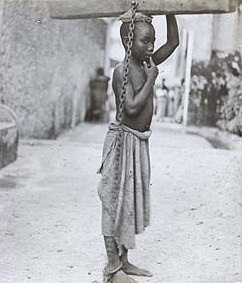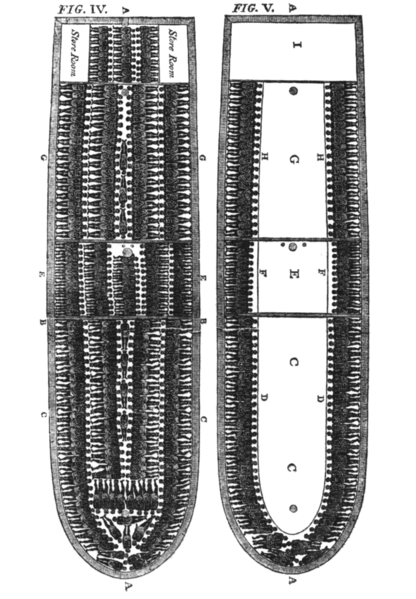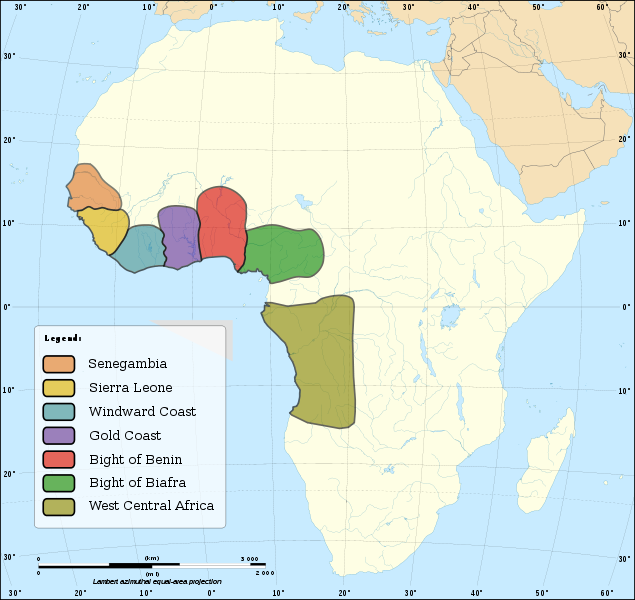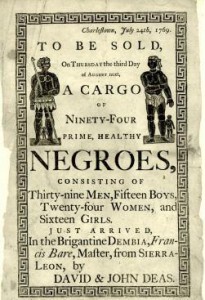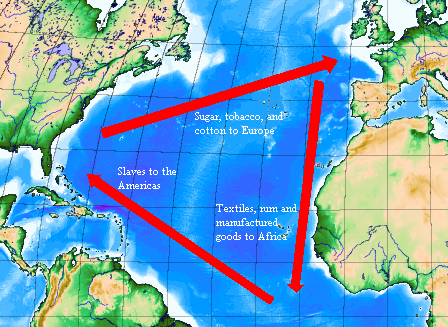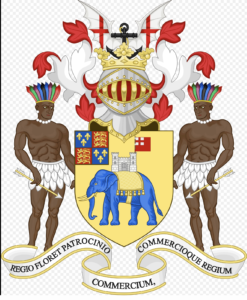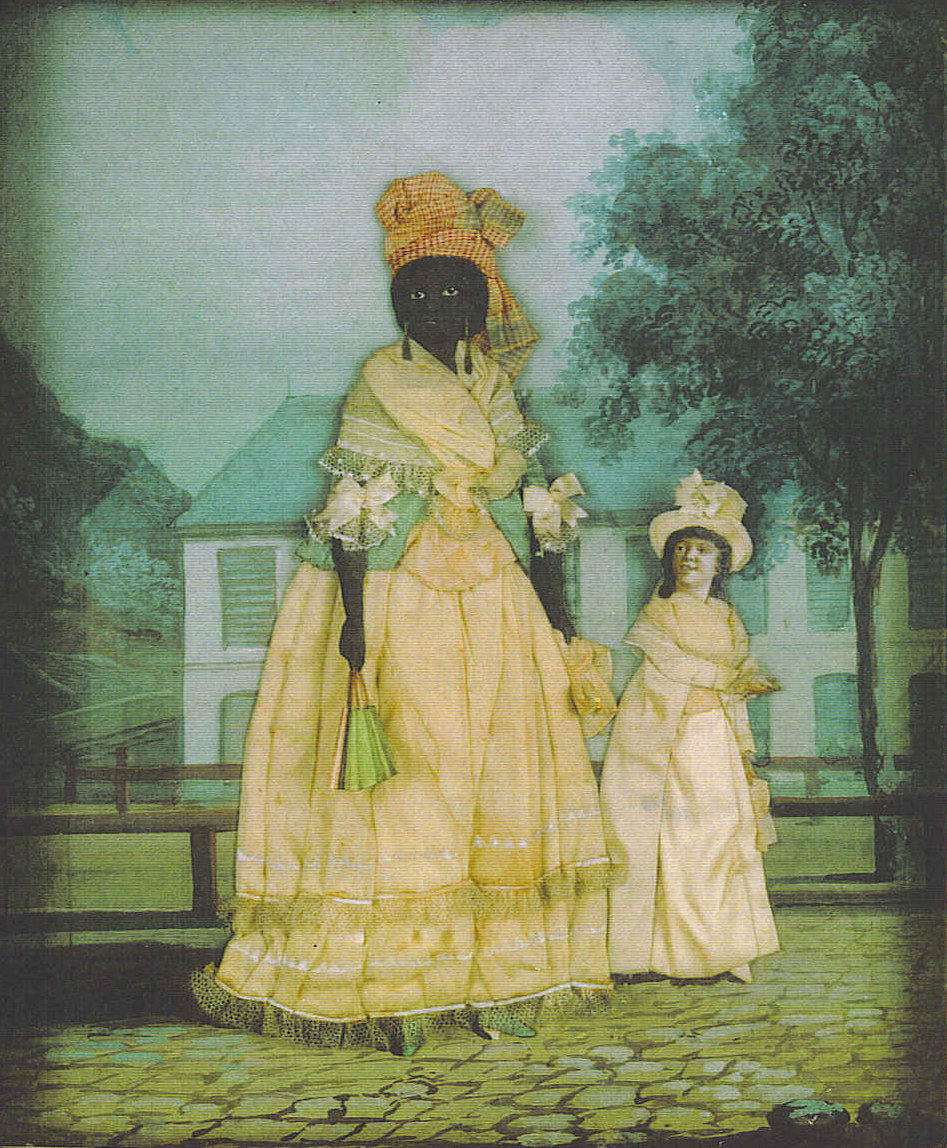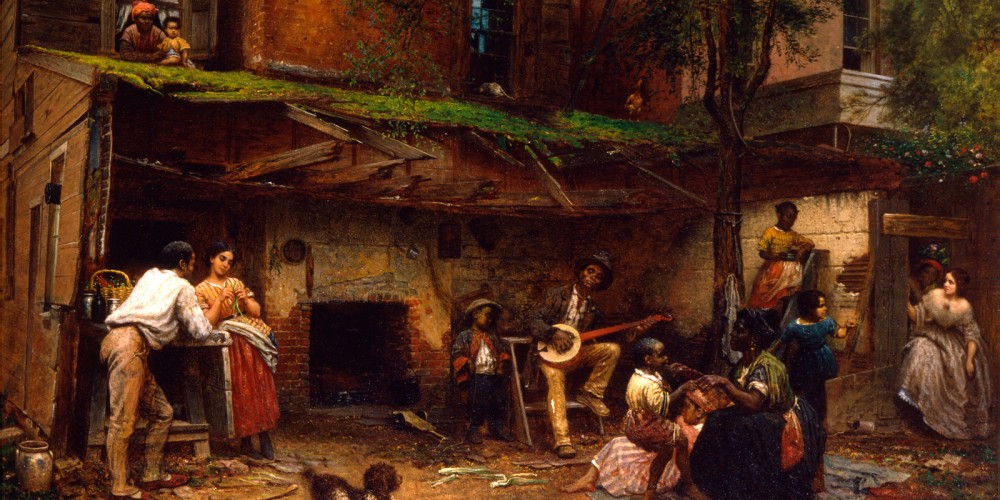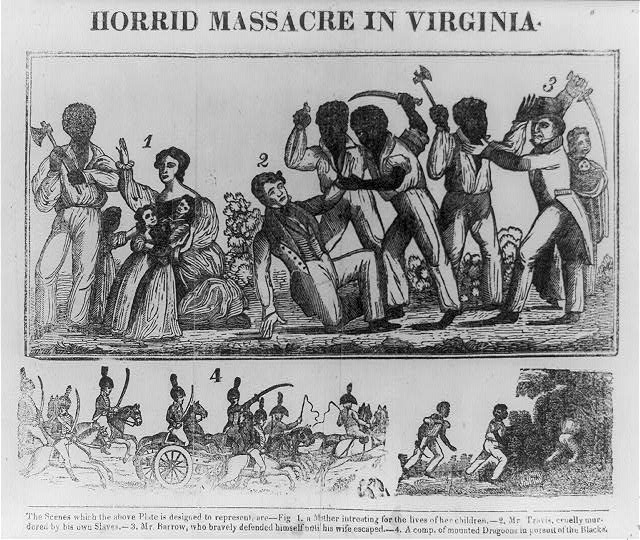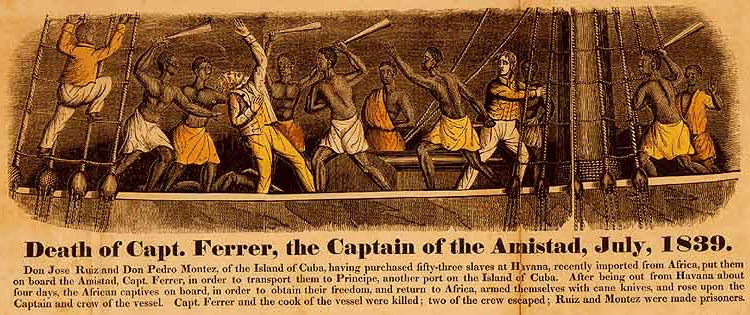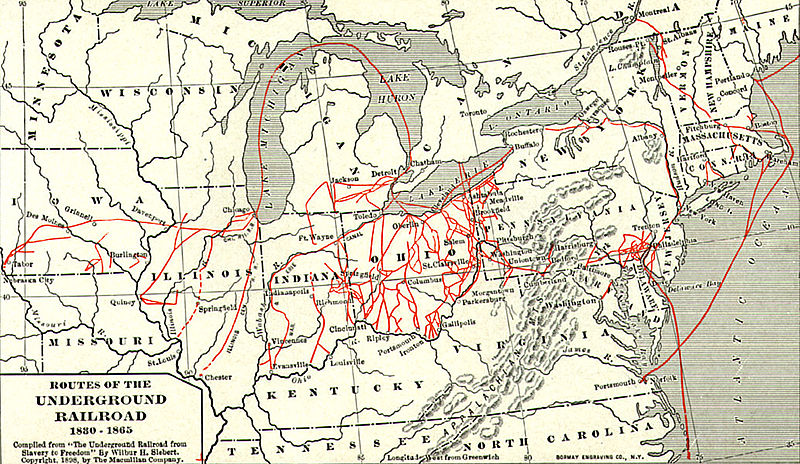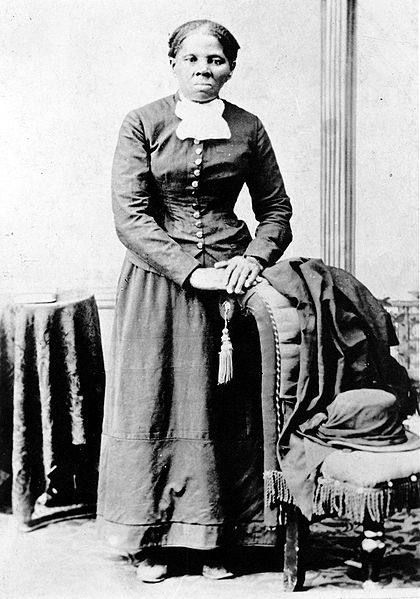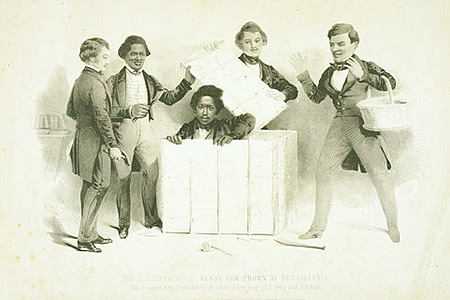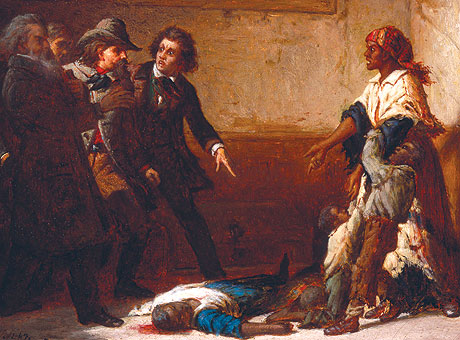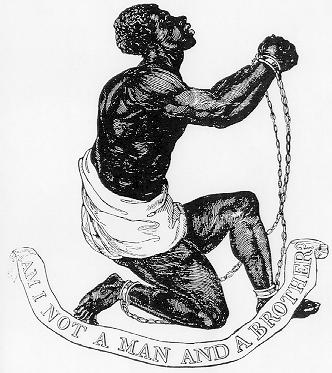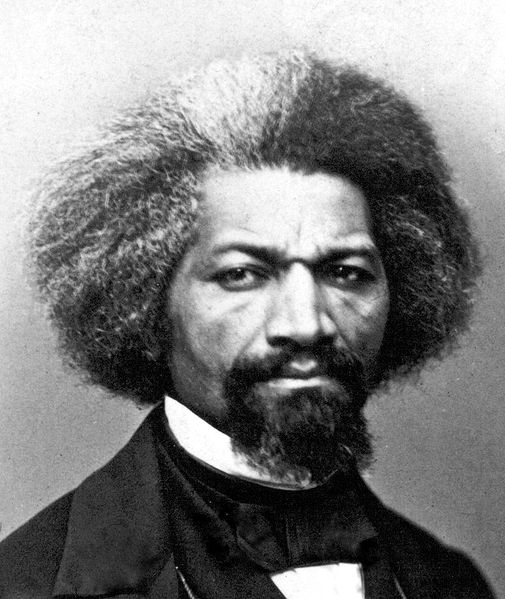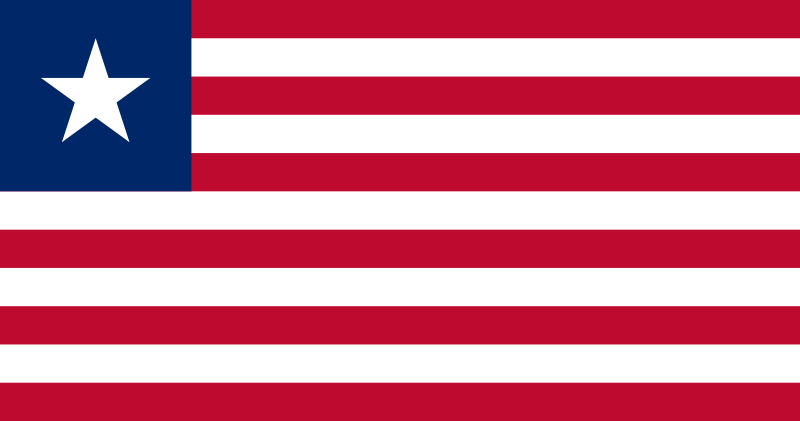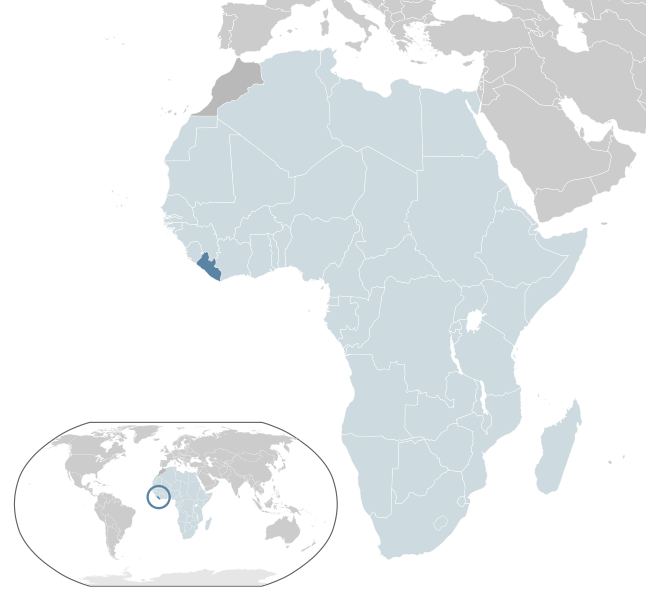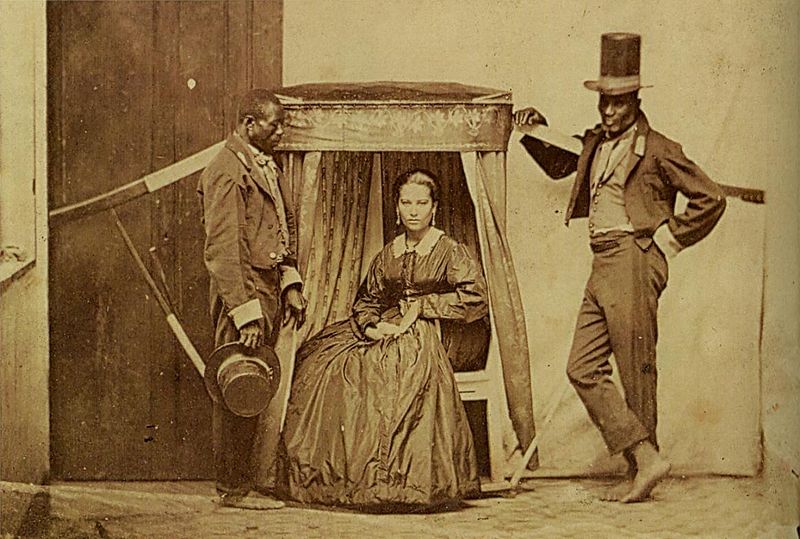Slavery has been more the norm than the exception in world history and continues today in various forms, usually associated with human trafficking. Among Native Americans, ancient Greeks and others, slave owners drew on POWs (Prisoners-of-War), debtors, or criminals. Romans enslaved Jews during the Great Revolt of 66-73 CE and forced them to build their famous Colosseum. As the Roman Empire expanded, large-scale raids became routine, though Roman slavery wasn’t racially based. Raids continued in the Middle Ages as Ottomans invaded southern and Eastern Europe to enslave Whites, and Arabs expanded into sub-Saharan Africa to trade in Africans’ existing networks. Christians and Maghrebi Muslims enslaved each other with impunity across the Mediterranean in the 16th and 17th centuries. Western Europeans also traded ethnic Slavs, whom they bought and sold on “slav markets.” The term is older, though, tracing to the Old French esclave and Medieval Latin sclava.
As Europeans expanded south during the Age of Exploration (Chapter 2), they also tapped into the African markets. When Portuguese explorers sailed down Africa’s west coast in the 15th century on their way to Asia, they traded copperware, cloth, horses, guns, wine, and iron tools for gold, ivory, raw copper, Raffia cloth, spices, exotic animals, and enslaved humans. They nurtured good relations with the victors in African civil wars then traded manufactured goods for POWs, especially in the Kingdom of Kongo and Kingdom of Benin. African sellers weren’t associating their human sales with race since people of all ethnicities bought and sold each other.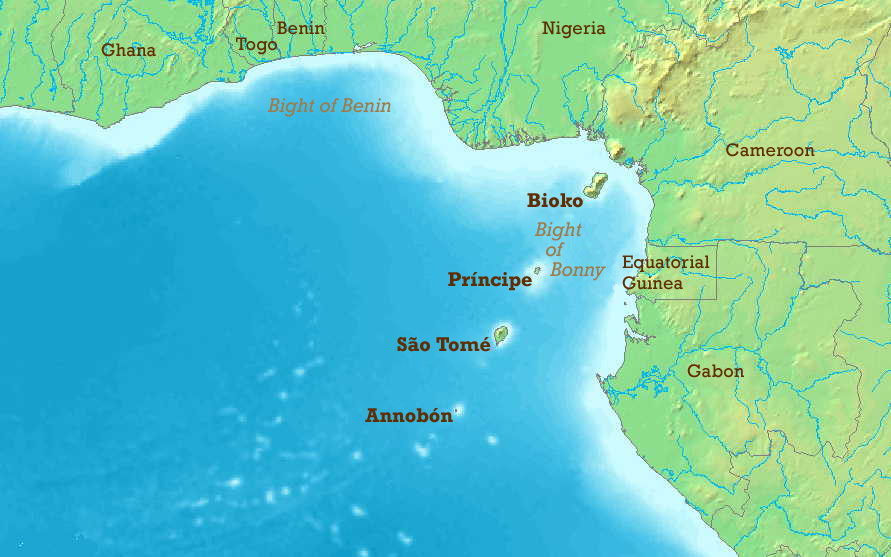
Portuguese exported the enslaved to work plantations on Atlantic islands like the Azores and Canaries and, if this 1570s painting from Lisbon is any indication, various roles in Portugal. Before that, they used enslaved workers to grow sugar even closer to Kongo in the Gulf of Guinea, on São Tome and Principe (above). They exported enslaved people out of the port of Luanda in Ndongo, just south of Kongo in what’s now Angola. Portuguese wars against Africans created yet more POWs that were sold into slavery to fuel the Brazilian sugar industry. When the Dutch arrived to aid Africans militarily against the Portuguese, they were just there to access the slave market themselves. The Spanish, English, and French followed suit, shipping the enslaved to the Americas and pirates, too, engaged in human trafficking. A new type of racially-based plantation slavery emerged in the Americas, as Europeans found it difficult to enslave Indians who knew the American terrain and they indentured white servants only on temporary contracts. It’s this more extreme phase in the history of human bondage that concerns us because of its scale and because it connects directly to colonial America and the United States. The U.S. and Brazil continued slavery after most countries deemed it too sadistic because it played such a big role in their economies. The slave-based plantation system in the American South seeded the early industrial revolution in the North by providing affordable cotton to textile mills that made fabric and clothing.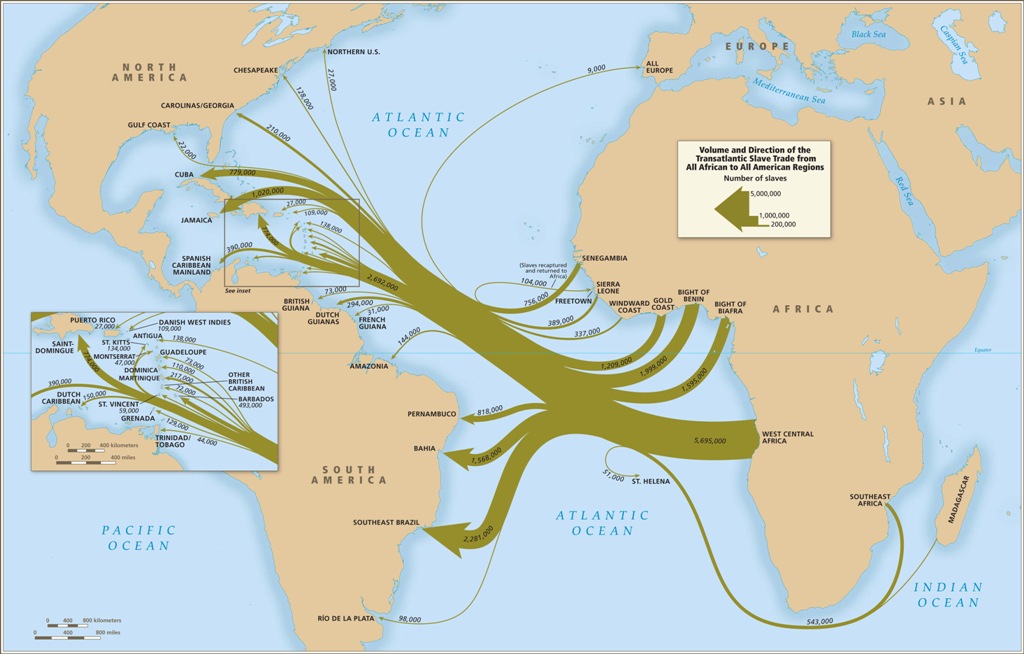
Atlantic Slavery
African tribes captured enemies, transported them to holding areas or forts on the coast, and sold them to Europeans. Most enslaved persons came from kingdoms near the western coast of the continent. Europeans supplied the demand and even armed African tribes to upset the balance of power and increase supply. European Slave Runners (or slavers) packed the human cargo into the holds of their ships on the Middle Passage to America. The French called the cargo bois d’ébène (ebony wood). They threw the dead to the sharks, who sometimes followed the boats, and brought the rest on deck from time to time to wash off their waste and vomit and exercise their atrophying muscles. The less muscle, the less price they’d fetch at auctions, pens (jails), and showrooms in the Americas. Women sometimes tore off parts of the boat to mutilate their genitals so that the crew would be less likely to rape them. The crew shuffled the captives so that people from different villages wouldn’t communicate, unable to overcome language barriers, as that lessened the chance of mutiny.
Once enslaved people arrived in the Americas, they were herded in coffles from ports to depots to plantations. Traders on horseback armed with whips and guns fastened them together with ropes, handcuffs, or chains, sometimes including neck collars, to avoid individuals separating from the group. That made water crossings dangerous both for the enslaved and the brokers that insured them. Thomas Jefferson’s cousin John Randolph, who owned hundreds of enslaved workers but freed them upon his death and gave them farmland, complained of the roads near his plantation “thronged with droves of these wretches and the human carcass-butchers, who drive them on the hoof to market.” Future U.S. President Andrew Jackson drove coffles as a boy, whereas future president Abraham Lincoln witnessed them as a boy and they turned him against slavery.
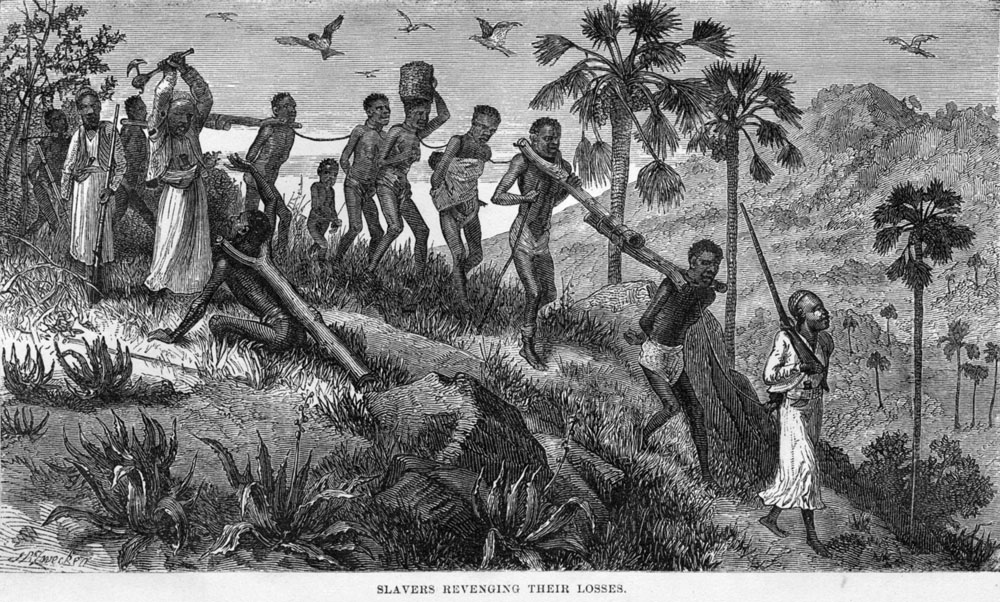
Central African Slave Coffle From 1865, Journal of David Livingston, University of Virginia Digital Library
Auction houses arranged enslaved captives in order of height from left-to-right, with children on the left and no regard for selling families as a unit. Buyers had them strip and dance and show their backs; too many scars could be a deal-breaker or lower value, indicating not cruelty from previous owners but rather defiance. New Orleans had over fifty markets. Whites could rent short-term servants on steamboats. The engraving below shows a slave auction at the St. Louis Hotel in New Orleans made famous by Harriet Beecher Stowe in Uncle Tom’s Cabin (1852). For extra money, buyers could insure themselves against enslaved workers that were rebellious, unproductive, or infertile. Aside from its sadistic and exploitive cruelty toward its victims, slavery also warped generations of owners, as emphasized by Stowe and mentioned by slaveowner Thomas Jefferson in Notes on the State of Virginia (1781):
“The whole commerce between master and slave is a perpetual exercise of the most boisterous passions, the most unremitting despotism on the one part, and degrading submissions on the other. Our children see this, and learn to imitate it; for man is an imitative animal.”
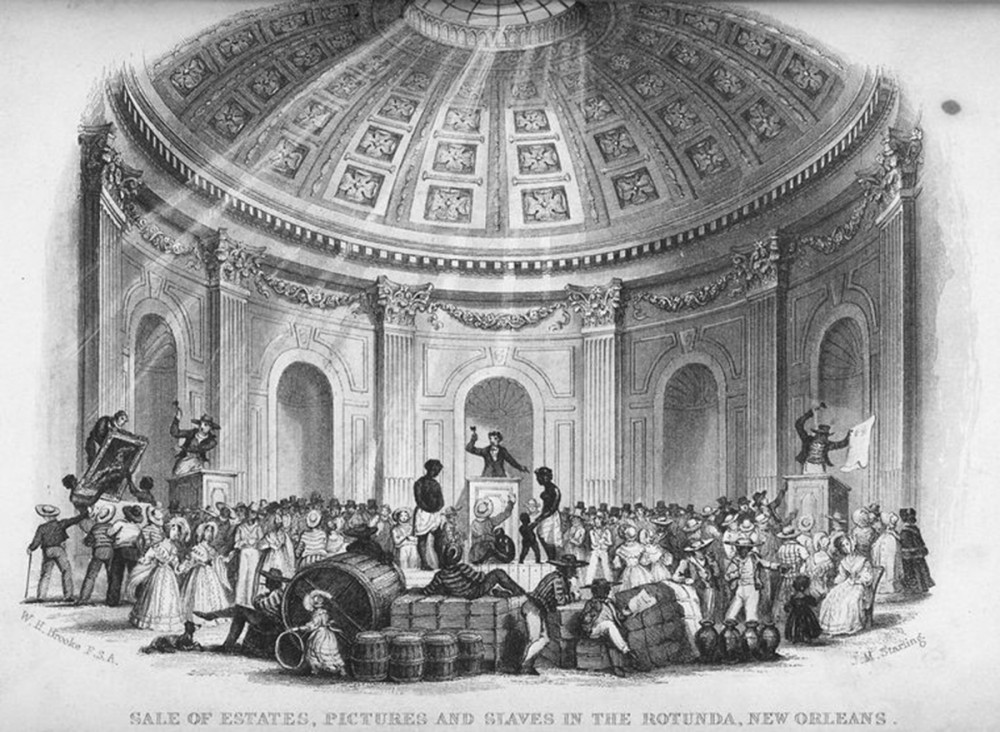
Sale of Estates, Pictures, and Slaves in the Rotunda, New Orleans,” Engraved by J.M. Starling After Work by William Henry Brooke, 1842
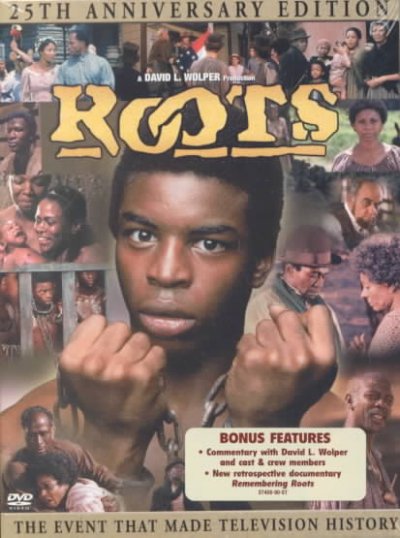 Twentieth-century Americans saw a graphic depiction of the Middle Passage and slavery in general with ABC’s broadcast of the Roots mini-series in 1977. Considering the textbooks of the time, it was a shocking revelation of the truth about slavery. It was based on the family history of author Alex Haley, who traced his lineage to his great-great-great-grandfather Kunta Kinte’s capture in West Africa. All eight episodes still rank in the top-100 most-watched shows in history, with the finale at #3. Shopping malls and Las Vegas casinos closed and silent customers sat watching in bars across America. The best-selling book and show also kicked off the genealogy movement, which is still going strong today despite the factual accuracy of Haley’s own research later being called into question (Wiki).
Twentieth-century Americans saw a graphic depiction of the Middle Passage and slavery in general with ABC’s broadcast of the Roots mini-series in 1977. Considering the textbooks of the time, it was a shocking revelation of the truth about slavery. It was based on the family history of author Alex Haley, who traced his lineage to his great-great-great-grandfather Kunta Kinte’s capture in West Africa. All eight episodes still rank in the top-100 most-watched shows in history, with the finale at #3. Shopping malls and Las Vegas casinos closed and silent customers sat watching in bars across America. The best-selling book and show also kicked off the genealogy movement, which is still going strong today despite the factual accuracy of Haley’s own research later being called into question (Wiki).
Enslaved workers were part of a trade network that included rum, sugar, and other items going back and forth between the Americas (especially the Caribbean and New England), Europe, and Africa known as the Triangular Trade. The diagram above shows a simplified version of how goods flowed, but the patterns shifted over the centuries. Most enslaved workers came to auctions in South America and the Caribbean, where they were sold to owners.
The first captive arrived in Spanish America in 1501. From the mid-17th century to the mid-19th century, more Africans came to America than Europeans. More came to South America than North, but Latin American owners usually bought males only, so there was no natural reproduction. The black population is higher today in North America because owners there bought females and encouraged families. Families likewise weren’t moved to the Middle East, where Arabs castrated enslaved males (today, the old servant term Abeed is used colloquially to describe black Africans). Historians estimate that around 12 million enslaved people came to the Americas from Africa, with 2-5 million dying in transit. Half a million who came to the portion that became the United States became 4 million by the outbreak of the Civil War. To put some perspective on those numbers, around 2.5 million free Britons came to colonial North America. Only 10% of British immigrants were free and came voluntarily; the other 90% were mostly-white indentured servants. Free Europeans were a minority in colonial America. Many enslaved captives made their way to North America via Barbados, often through the British Royal African Company (right).
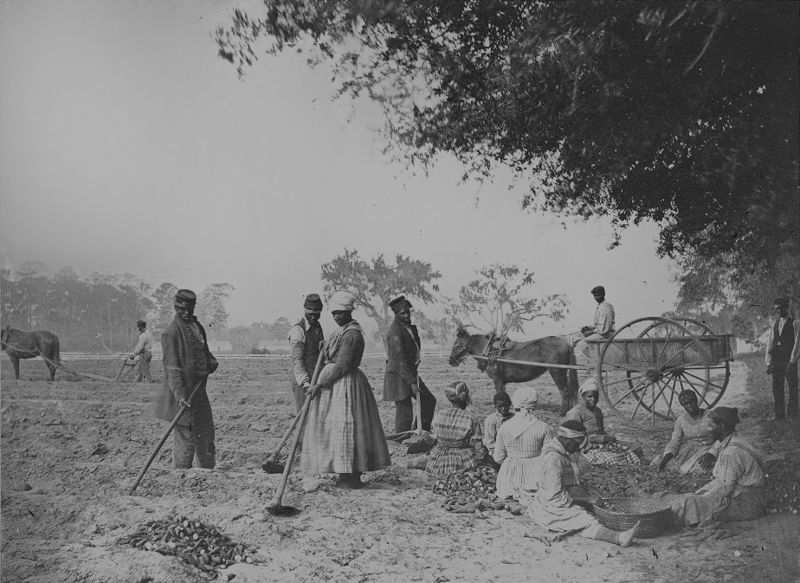
Slaves Planting Sweet Potatoes @ James Hopkinson’s Plantation in Georgia, Photo by Henry Moore, New York Historical Society
The further south one went in the Americas, the larger plantations got. Enslaved workers outnumbered Whites in the southern part of Carolina Colony with higher ratios yet in the sugar-growing Caribbean, where absentee landowners often hired overseers and stayed in Britain, France or the Netherlands. As mentioned in Chapter 5, sugar was a luxury item that generated higher profits than other crops. It was a key ingredient for rum and for processing the bitter core of the cocoa plant into chocolate. Both processes were arduous and labor-intensive. Enslaved workers grew sugar, from which planters made rum that they used to buy more workers in Africa.
Slavery was legal throughout the colonies that later comprised the U.S. In New England, most were family servants or sourced out for manual labor (e.g. dockworker). Slavery and indentured servitude came to the Chesapeake region around Virginia and Maryland in the 17th century because of tobacco. We already saw in Chapter 5 how wealthy Virginians drove a wedge between Blacks and Whites by racializing slavery and expanding suffrage (based on land ownership) to Whites, closing ranks racially. One goal was avoid poor Whites and Blacks teaming up the way they had during Bacon’s Rebellion in 1676, though the process was underway by the 1660s. Racialized slavery connects naturally to racism, because rationalizing it morally and religiously involves seeing enslaved people as sub-human. That’s a core way that slavery, in turn, connects to modern American history. Historian Eric Williams (first Prime Minister of Trinidad & Tobago) argued that racism was a consequence rather than cause of slavery, and that [originally] “unfree labor of the New World was brown, white, black, and yellow.”
Further south, enslaved workers grew rice and indigo in Carolina and, later, sugar in Louisiana and cotton across the Southeast, then known as the Southwest. Rice cultivation involved working waist-deep in paddies filled with leeches and snakes. Most of the children who worked rice in South Carolina died from snakebites or malaria. In between growing crops, captive workers raised barns, built fences and roads, drained swamps, sewed clothes, and prepared food for Whites.
After the cotton gin made cotton a more profitable crop (previous chapter), slavery’s center of gravity shifted to the Deep South, causing the largest forced migration in American history as tobacco workers in the Upper South were sold off and marched to the Deep South. In what historians now call the “Slave Trail of Tears” — like the smaller but more famous march of southeastern Indians west to Oklahoma — roughly one million enslaved workers left Virginia and Maryland in coffles destined mainly for Louisiana and Mississippi, creating a “thousand-mile river of people” in the decades before the Civil War. The two were connected as the Native American Trail of Tears was the very thing that cleared the space for settlers who then initiated the enslaved Trail of Tears. The latter included more people than went west on the wagon trains of the Oregon Trail. Some went south on steamboats via the Ohio and Mississippi Rivers, leading to the phrase “sold down the river.”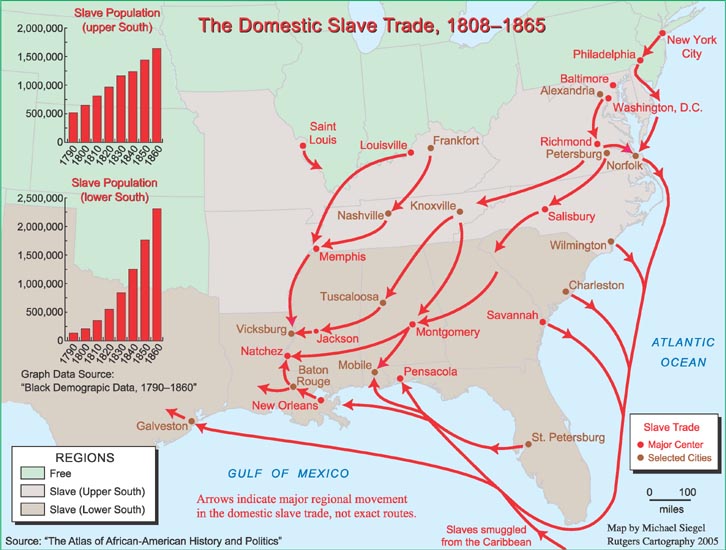
Tobacco workers fetched high prices in the Deep South on the theory that they were less overworked than sugar workers and their trade became one of the country’s big businesses. The Franklin & Armfield Office in Alexandria, Virginia and New Orleans, with slave pens adjacent to its auction houses, borrowed a full 5% of the credit extended by the Second Bank of the United States. Adjusted for inflation, over half a billion dollars’ worth of human beings left Richmond in 1857 alone. By the mid-19th century, Natchez, Mississippi, terminus of the Waller Coffle Route, had the most millionaires per capita in the U.S. and the largest “Negro mart” at Forks-of-the-Road. Cotton planters not only made a lot of money, the involuntary workers that grew it also enriched textile manufacturers and shippers in the North and Europe. Though its workers were increasingly limited to the American South, slavery thus sustained a broader Atlantic economy and helped launch the Industrial Revolution.
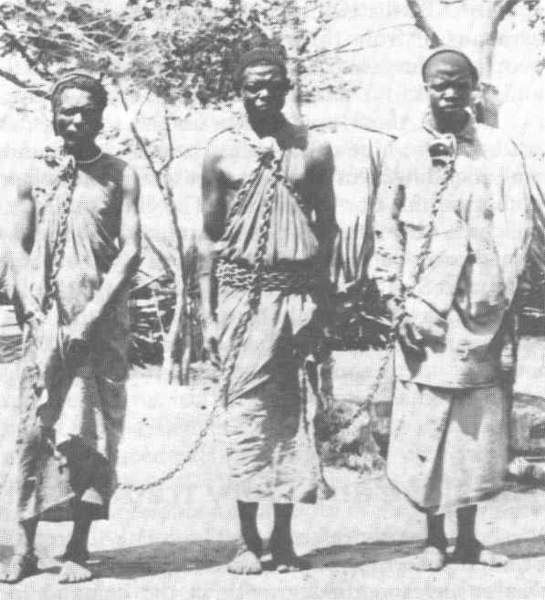 Enslaved Life
Enslaved Life
Workers’ lives varied depending on their location. Single Africans owned by town families or small farms acculturated more quickly to Euro-American society, while many of the enslaved on large sugar or cotton plantations interacted less with Whites. In those cases, African culture survived longer in the form of religion, music, customs, and dialect. These plantations shuffled people from different regions, similar to the ships, so that English and Christianity usually prevailed as the default language and religion, even if both assumed different versions than their white counterparts. Gullah, spoken on the coastal plain and Sea Islands off the South Carolina and Georgia coast, is one famous African-American dialect, but there were others. African words in English include banana, banjo, chemistry (Egyptian), chimpanzee, ebony, jumbo, safari, yummy, zebra, and zombie.
Black Christianity was more optimistic and less focused on damnation than the white version, and the music more celebratory. The story of the Jewish Exodus out of Egypt naturally resonated with captives because of its emancipatory message, just as the Puritans had identified with its theme of a chosen people. Enslaved workers often participated in their own services on Saturday nights and with Whites on Sunday mornings. Whites encouraged marriage but revised vows to read, “Until death or distance do us part.” That was an important distinction. The enslaved used the terms brother, sister, aunt, and uncle for everyone on plantations to soften the blow of losing their own nuclear family at a moment’s notice to sale or trade. Escapees could often be located searching for lost spouses or children on neighboring plantations. The big migration from tobacco to cotton country exacerbated this problem.
Skin tone mattered. On large plantations, those with lighter skin could work in the home as domestics, while the rest were arranged in concentric circles of increasingly dark skin further away from the mansion, with the darkest rarely venturing near the house except to send messages or requests through the lighter-skinned house servants. Scholars call such phenomena colorism. In a 1963 speech, civil rights leader Malcolm X referenced the tension between enslaved workers in a thinly-veiled attack on Martin Luther King, implying that King was more of a “house negro” because of his support for integration and willingness to work with whites progressives.
For more on colorism, see the optional Monk article below.
Work varied more than modern people commonly imagine. Men worked as mechanics, carpenters, or around the barn, while women, children, and the elderly worked in the fields, sometimes passing the time singing call and response songs that later influenced gospel, blues, jazz, and hip-hop. In order to get around the inherent problem of people not working hard since they weren’t paid, some plantations instituted task systems that gave workers the rest of the day off after they completed their assigned tasks. Some grew vegetable gardens on the side during this free time to raise extra cash, but purchasing guns, horses, and boats was forbidden.
On rare occasions, some enslaved workers made enough money to purchase their own freedom, in effect buying themselves. Considering that puts slavery in perspective. Imagine if, in addition to paying your usual bills, you had to save up money for years to buy yourself. Free Blacks could be re-captured, though, and auctions like the one in Montgomery, Alabama were notorious for not requiring the seller to show paperwork verifying that the person was actually enslaved. On very rare occasions, free Blacks enslaved other Blacks where state law allowed (Virginia, for instance, banned the practice in the 17th century). Around 0.1% of southern slave-owners (one in a thousand) was black. Here’s data from the 1860 census:![Source: Inter-university Consortium for Political and Social Research, "Historical, Demographic, Economic, and Social Data: The United States, 1790-1970" [Computer file] (Ann Arbor, MI: Inter-university Consortium for Political and Social Research, 1997)](https://sites.austincc.edu/caddis/wp-content/uploads/sites/106/2017/11/1860censusdatafreeblackwhiteslaves.png)
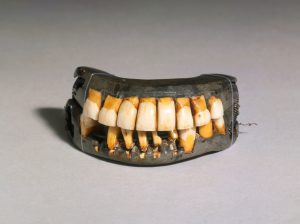
George Washington’s Dentures, Photo Courtesy of Mount Vernon Ladies Association & Washington Papers, UVA
Regardless of their location or job, workers were property and could be brutalized, raped, and murdered, though the latter wasn’t the normal course of events. A 1669 Virginia Law codified the exoneration of any master for murdering an enslaved worker (Digital History). Murdering the enslaved, while legal, cost the owner a valuable investment and amounted to the destruction of property if someone else committed the crime. Murder happened, though, sometimes to set an example or just casual recklessness. Abolitionist Sarah Grimké wrote of one owner who bet a dinner guest that Africans could never be real Christians. To prove his point, he tried to beat a worker until he revoked his faith but he refused, so he beat him to death. Torture, in the form of pouring salt in wounds, castration, rubbing in pickle juice and bird pepper, and tying people up over anthills, was usually meted out against captured escapees or the relatives of those who successfully escaped. Rape, though, was par for the course – a perquisite of owning female property, as evidenced by letters passed among plantation owners from the antebellum (pre-Civil War) era. And there were numerous smaller indignities, too many to list here. For example, when founder George Washington lost his teeth, he extracted his workers’ teeth to make his dentures (right).
One Jamaican planter, Thomas Thistlewood, kept track of his conquests, writing in his diary that he’d raped enslaved females 3,852 times and how he’d invited guests to join. When Thistlewood tortured workers he had others urinate or defecate in their eyes and mouth and then gagged them. He called it “Darby’s Dose” after a man named Darby he caught eating sugar. Some planters bought and sold “fancy girls” specifically for raping. One auction in New Orleans dealt exclusively in the mixed-race “fancy trade” of “mulatresses.” Forced relationships between owners and enslaved females are why there were lighter-skinned Blacks to serve as the house servants. Rape was especially common as captives were being transported in coffles because the women were too tired to resist after marching all day. Most African Americans today have around 12-25% European DNA.
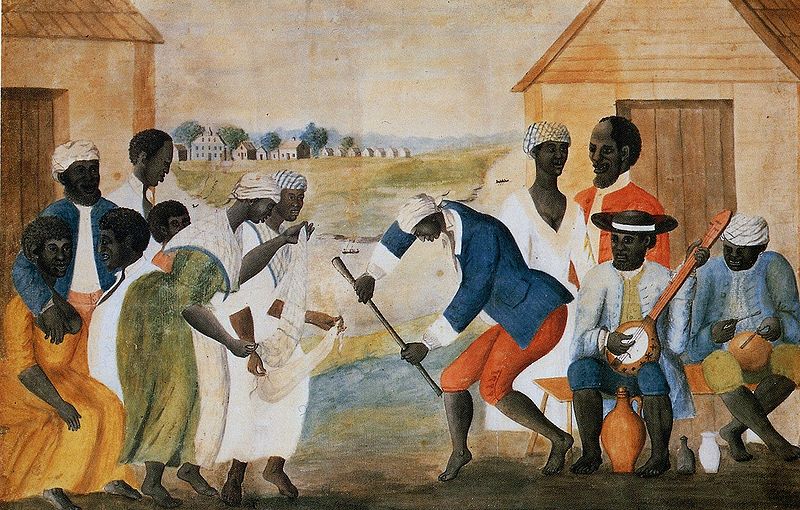
The Old Plantation (Slaves Dancing on a South Carolina Plantation), ca. 1785-1795, Attributed to John Rose, Beaufort County, South Carolina, Abby Aldrich Rockefeller Folk Art Museum, Williamsburg, Virginia
In South Carolina, captured fugitives (escapees) were sometimes tied to posts where they were gradually pecked to death by birds, with their rotting corpses left to putrefy the air for miles around and send a message to others. Others were forced to wear bells or other elaborate contraptions on their heads to warn others if they ran off. Planters also spread misinformation to justify their own brutality. As we saw in Chapter 5, 17th-century minister Morgan Godwyn attributed these rumors to “our Planters chief deity, Profit. They’ll infer their Negro’s Brutality…to justifie [sic] their reduction of them under Bondage; disable them from all Right and Claims.”
Some owners were relatively benevolent and took great pride in treating their chattels with respect and dignity — at least in their subjective interpretation, and as much as could be afforded under the circumstances. That was supposedly the case on the plantation where Jefferson Davis grew up, who became president of the Confederacy in 1860. Nearly all white descendants of slave-owners remember ancestors notorious for treating their people better than other owners. The painting below was controversial because Southerners argued that it showed the cheerfulness of slave life, while Northerners pointed to the dilapidated housing and subtle suggestions of miscegenation. Artist Eastman Johnson, who later founded the Metropolitan Museum of Art in New York, was depicting an everyday scene near his father’s home in Washington, D.C.
Pro-slavery propagandists cherry-picked their examples to promote the peculiar institution as the debate over slavery heated up in the 19th century. Even in the more benevolent cases, though, enslaved people had no freedom to dictate the course of their own lives. Sometimes the friendlier owners hired “slave-breakers” to beat workers into submission and break their will when they were first purchased, affording them the opportunity to be less harsh down the road. Nonetheless, by the time the Civil War broke out, Confederates wrongly asserted that Blacks enjoyed slavery and that propaganda worked its way into some history textbooks well into the 20th century.
Revolts & Escape
They didn’t, but large-scale rebellions were infrequent, with only 20 or so notable examples occurring over the centuries. Smaller ones took place maybe once a year on average in colonial America, but only around 1/3000 enslaved persons ever took part. Revolts were destined to fail in the face of armed white militia, as was the case in Bacon’s Rebellion (1676), or foiled by poor planning (Stono Rebellion in South Carolina, 1739), bad weather (Gabriel’s Revolt in Richmond, 1800) or betrayal (Denmark Vesey in Charleston, 1822 and Gabriel’s Revolt). In order to keep news of the one successful slave revolt in the Western Hemisphere — the Haitian Revolution of the 1790s — from enslaved Americans, constables imprisoned free black sailors in ports like New Orleans, Mobile, and Charleston during the duration of their ship’s stay (e.g. South Carolina’s post-Vesey Negro Seaman Acts). Masters rewarded other workers generously for turning in potential rebels. A series of fires in New York City in 1741 was blamed on the enslaved and poor Whites, but historians argue that they were framed. Around 20 were executed. The largest rebellion was the German Coast Uprising in Louisiana in 1811, but only two Whites died and militia killed 95 enslaved workers, some after the post-uprising trials. In retrospect, these rebellions were really suicide missions by desperate people who’d been pushed too far. The enslaved were often outnumbered and always out-armed.
Nat Turner’s 1831 revolt in Virginia also failed, but not before Turner and his followers killed 60 Whites, including women and children. The violent uprising gained recent media attention with the release of Nate Parker’s Birth of a Nation in 2016. In 1831, authorities distributed the perpetrators’ severed heads on fence posts around Virginia, same as with the Stono Rebellion in 1739. Whites fashioned the perpetrators’ bones into trophies, boiled their flesh into grease, and sewed their skin into souvenirs. They wrenched, skinned, quartered, and decapitated Turner, hoping that his dismembered body would prevent his soul from entering the afterlife. Turner, Vesey, and Gabriel moonlighted as either political rebels versed in the rhetoric of the American and French Revolutions or ministers versed in inspirational Biblical passages. The timing of the revolt was inspired by Turner viewing a solar eclipse in February, then a bluish-green tint in the sunset caused by the eruption of Mt. St. Helen’s in August. One effect of Turner’s actions was a widespread illiteracy campaign making it illegal for the enslaved to read in most of the South. That way, the Bible and Declaration of Independence, with its hypocritical call for freedom, could be kept from the enslaved. Nat Turner’s Revolt ushered in a general era of paranoia that included mail censorship in the South and a Gag Rule in Congress, whereby it became illegal for Congressman to discuss abolition in the nation’s capital, First Amendment be damned. Whites also disarmed free blacks in neighboring states like Delaware. Turner became more famous later with publication of a sensationalized, fictional account by William Styron, The Confessions of Nat Turner (1967), inspired by Turner’s prison testimony to his attorney, Thomas Ruffin Gray.
A notorious rebellion took place off the Cuban coast on the slaver La Amistad. The captives mutinied and demanded to be returned to Africa. Due to some clever navigating by the captain (especially at night), the boat ended up off course in New England instead, a relative abolitionist hotbed, where the fate of the captives turned into a high-profile case that landed in the Supreme Court. The Court freed the mutineers because the Constitution outlawed the Atlantic slave trade twenty years after its 1788 passage, in 1808. Former President John Quincy Adams defended the captives pro bono (free of charge). Steven Spielberg directed an all-star cast in Amistad (1997), with Anthony Hopkins playing Adams.
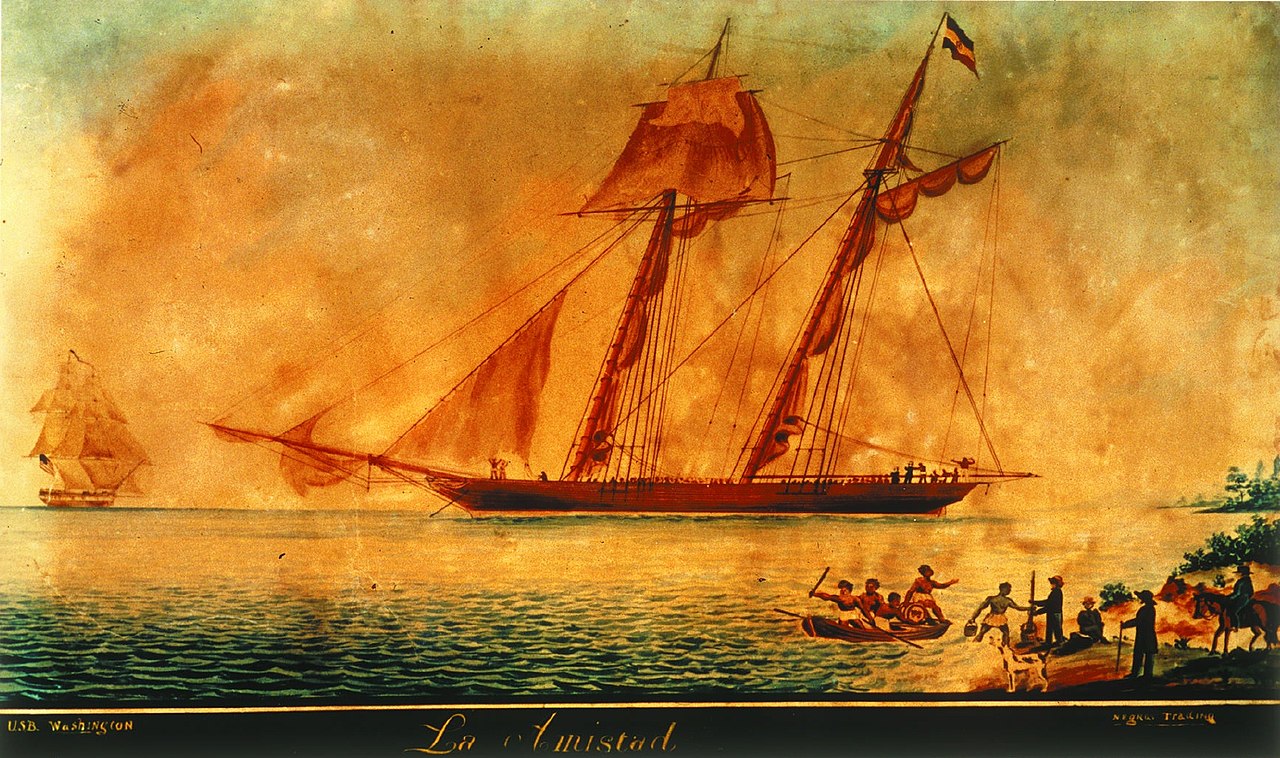
La Amistad Off Culloden Point, Long Island, New York, 26 August 1839, New Haven Colony Historical Society & Adams National Historic Site
More common than actual rebellions were passive forms of resistance, such as running away, working slow, petty theft, or food poisoning: the most common way for enslaved workers to kill their owners. Usually, those in bondage negotiated their working conditions through more subtle means than murder or outright rebellion. Lying out was a temporary form of running away among those who would hide out in the woods for a few days before boredom, loneliness, and hunger usually compelled them to return voluntarily. Better off were those who escaped to Mexico or met up with welcoming Indian tribes in the Deep South, such as Cherokees or Seminoles. But, prior to 1866, there were also indigenous tribes that enslaved African Americans, fellow Native Americans, and some European Americans (Wikipedia). In the Caribbean, some escaped to pirate ships and a considerable percentage of pirates were African-American.
For a lucky few, the best route out in the Upper and Mid-South was the Underground Railroad, a network of sympathetic Whites and free Blacks who sheltered passengers in cellars, attics, or barns during the day, then directed them via conductors where to travel by night to the next station on the railroad. The name came from a bounty hunter who complained that his target eluded him “as if disappeared underground.” There were various routes. The “Metropolitan Corridor,” for instance, connected stations from Virginia and Maryland through the urban Northeast to Canada, often via the Erie Canal. Sometimes passengers would travel by day hidden under crops in wagons. Sewing bees made new clothes so that passengers on the rail could change at their stations. There were secret code words embedded in songs that referred to the Underground Railroad. The drinking gourd (the handle of the Big Dipper) helped guide passengers over the River Jordan (the Ohio) to the Promised Land (the North). The Ohio River took on the same meaning the St. Mary’s River had in colonial times when refugees could escape British America to St. Augustine in Spanish Florida. In the 19th century, runaways turned north instead. Heaven sometimes referred to Canada while chariot meant Underground Railroad. According to some, the stitching in quilts could also communicate messages as a sort of “Morse Code,” especially if the blankets were hanging out to dry at key points on the route.
Some historians are skeptical about how extensive the network really was because so few escaped on it, but most of those that tried, made it. The National Geographic Society estimates that ~ 100k enslaved people “rode” the Underground Railroad to freedom. It has an inspirational history and some of its conductors, including Harriet Tubman and William Still, were among the most famous abolitionists of the 19th century. William Still even helped one escapee whom he discovered to be his long-lost brother. Tubman also worked as a spy and scout during the Civil War. She made the news in 2020 when musician and presidential candidate Kanye West said, without providing evidence or further context, that Tubman “never actually freed the slaves, she just had them work for other white people.”
One resourceful man, Henry Brown, even managed to mail himself to freedom in a box. But owners made escaping a selfish act by torturing relatives and those left behind for retribution. Those lucky enough to escape north of the Mason-Dixon Line, dividing Maryland and Pennsylvania, or the Ohio River, dividing the remainder of the country east of the Mississippi, were still subject to bounty hunters with smelling dogs. Margaret Garner escaped with her family across the Ohio River when it was frozen over. When she was captured, she killed two of her children to prevent them from being returned to the South. She apologized for not being able to kill the rest, saying that she’d done everything in her power to be the best mother she could be. Southerners argued that Garner’s actions proved Blacks were subhuman and thus needed the paternal care of Whites. For northern abolitionists, her story underscored the inhumanity of slavery itself, not Garner. Later, Garner’s story inspired novelist Toni Morrison’s Nobel Prize-winning Beloved (1987). In the early 2020s, that novel emerged in the culture wars as Republican legislatures in some states banned it from being read in public schools.
Within the U.S., bounty hunters could identify fugitives by their tattoos since they were branded. Only Canada or Mexico provided truly safe havens, though a few free black settlements held out during the Seminole Wars (1816-1858) in Florida along the Gulf Coast (e.g., Negro Fort). Canada outlawed slavery in 1834 and Mexico in 1829, though recent evidence suggests that some Mexicans were illegally enslaving Mayans past 1829. The Rio Grande Valley along the Texas-Mexico border had several free black settlements and there was likely a route to freedom along El Camino Real de los Tejas, a trail connecting Natchitoches, Louisiana to Mexico City. Slaveholders did their best to convince the enslaved that Canada was a land of famine where Whites ate Blacks and shaved their heads to make collars for warmth in the winter. Violence could also break out between bounty hunters and runaways, as happened in the escape of 20 African Americans from Native Americans in the 1842 Slave Revolt in the Cherokee Nation.
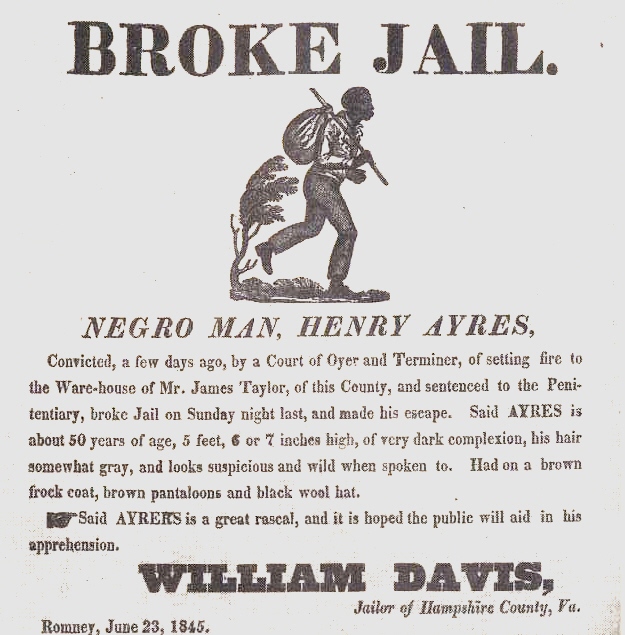 Some Northerners made money cooperating with bounty hunters while others protected refugees and free Blacks in danger of being kidnaped. High-ranking politicians in New York City formed the “Kidnapping Club” to “pimp for slaveholders.” But in the case of David Ruggles’ New York Committee on Vigilance, a combination of free Blacks and Whites provided protection against such abuses. Sydney Howard Gay published the National Anti-Slavery Standard (1840-1870) in New York and kept detailed records of aided fugitives, linked below at the bottom of the chapter. After Anthony Burns’ kidnapping in Boston, abolitionists there formed the Anti-Manhunting League. Such organizations laid the foundation for the Underground Railroad of the 1850s. Ruggles’ abolitionist magazine, The Mirror of Liberty, was the first periodical edited by an African American. When human traffickers captured free northern Blacks and sold them into slavery, as was the case with Solomon Northup in 1841, it was difficult to sue for freedom or compensation because Blacks couldn’t use the courts as plaintiffs. Northup’s 1853 memoir, 12 Years a Slave, was popular among abolitionists and turned into a well-regarded movie in 2013. Like Harriet Beecher Stowe’s Uncle Tom’s Cabin (1852), 12 Years a Slave underscored not only the brutality of slavery but also the way it debased masters and slave-hunters.
Some Northerners made money cooperating with bounty hunters while others protected refugees and free Blacks in danger of being kidnaped. High-ranking politicians in New York City formed the “Kidnapping Club” to “pimp for slaveholders.” But in the case of David Ruggles’ New York Committee on Vigilance, a combination of free Blacks and Whites provided protection against such abuses. Sydney Howard Gay published the National Anti-Slavery Standard (1840-1870) in New York and kept detailed records of aided fugitives, linked below at the bottom of the chapter. After Anthony Burns’ kidnapping in Boston, abolitionists there formed the Anti-Manhunting League. Such organizations laid the foundation for the Underground Railroad of the 1850s. Ruggles’ abolitionist magazine, The Mirror of Liberty, was the first periodical edited by an African American. When human traffickers captured free northern Blacks and sold them into slavery, as was the case with Solomon Northup in 1841, it was difficult to sue for freedom or compensation because Blacks couldn’t use the courts as plaintiffs. Northup’s 1853 memoir, 12 Years a Slave, was popular among abolitionists and turned into a well-regarded movie in 2013. Like Harriet Beecher Stowe’s Uncle Tom’s Cabin (1852), 12 Years a Slave underscored not only the brutality of slavery but also the way it debased masters and slave-hunters.
Northern states were constitutionally obligated to return stolen property to the South because of the Fugitive Slave Clause. Like an earlier controversy over the tariff and the later controversy over secession, this debate manifested as an argument over states’ rights. In this case, Northerners favored the right of states to ignore or nullify the national government’s rule within their state, whereas Southerners favored national over state power, affirmed in Ableman v. Booth (1859). While there was enough states’ rights sentiment in the North for some to advocate secession from the pro-slavery U.S., the movement never gained traction on the scale it did in the South in 1860.
Abolition
Abolitionists were rare in the North. Most Northerners were racists and their textile industry was just the downstream portion of the cotton economy. Shippers, bankers, and investors also profited from the cotton market. Sugar was a common household item too and, to their credit, dedicated abolitionists took pains to substitute honey and not wear cotton. A small but vocal group of Quakers and evangelicals actively promoted abolition and some started newspapers dedicated to that cause. On this score, northern Christianity mounted a more consistent challenge to slavery than the Enlightenment had. Enlightenment guru Ben Franklin was a latecomer to abolitionism in his early eighties, writing a parody of stateside pro-slavery arguments in which he justified Muslims in Northern Africa enslaving white Christians. Anyone who read it could instantly see the self-serving argumentative contortions Americans went through to justify enslaving Africans. British abolitionism also grew in the late-18th and early-19th centuries and they abolished slavery in 1833. The famous “Am I Not a Man and a Brother?” image appeared on medallions distributed by Josiah Wedgwood, a prominent English pottery manufacturer and grandfather of Charles Darwin mentioned in the previous chapter.
A few white Southerners opposed slavery, too, including Sarah and Angelina Grimké of Charleston, South Carolina. Hall of Fame baseball player Ty Cobb, though a notorious and violent racist himself, descended from a family of Georgia abolitionists, one of whom refused to fight for the Confederacy for that very reason. Free Northern Blacks were also active abolitionists. Sojourner Truth and Frederick Douglas were among the most famous. Douglas was one beneficiary of New York’s forenamed Vigilance Committee, who offered him shelter, money, advice, and a new identity when he first fled his Maryland plantation. In Philadelphia, Blacks “sat in” at white churches, similar to the protests of the 1960s, before Richard Allen and 20 others founded the African Methodist Episcopal Church in 1816.
The default progressive position among Whites, promoted by both Thomas Jefferson and Abraham Lincoln until midway through the Civil War, was the Back-to-Africa movement. As Jefferson explained, Whites had the “wolf by the ears.” To wit, he thought integration was unfeasible because resentful Blacks would lash out at Whites as retribution for centuries of slavery. Better to gradually emancipate people and send them back to Africa to re-colonize, according to this line of thinking. Some free Blacks and plantation owners also endorsed colonization. Most enslaved people didn’t want to go to Africa and slave-owners didn’t want to forfeit their property. Nonetheless, there was some colonization. The American Colonization Society succeeded in founding one country, Liberia, but the colony never took hold on a large scale. Most African Americans had been away from Africa for generations and going home in the 19th century entailed the culture shock of new languages, food, traditions, etc. African-American abolitionist David Walker wrote of America: “We have enriched it with our blood and tears.” Repatriated Americo-Liberians wrote a republican constitution, but some enslaved Africans and set up American-style plantation systems. They didn’t grant native Africans citizenship until 1904. Americo-Liberians ran the country from its founding, in 1847, until 1980. Until the mid-20th century, it was the only portion of Africa not controlled by Europeans.
Black Loyalist ex-slaves from Nova Scotia, who escaped to Canada during the American Revolution, founded a similar colony nearby called Freetown in Sierra Leone, but that later became a British colony. One of George Washington’s enslaved workers, Harry, who escaped during the Revolutionary War, ended up in Sierra Leone. During that war, Washington’s aide-de-camp Alexander Hamilton (future Treasury Secretary) tried to convince him to free all the enslaved to serve in the army against the British. Instead, the British beat him to it in 1775 with Dunmore’s Proclamation and got a few freed workers to fight for the Loyalists before they were mostly wiped out by smallpox. For Washington, like many of the Founders, American freedom meant African servitude. If they’d freed enslaved workers to help win the war, they wouldn’t have won a country with a built-in unpaid labor force. To his credit, though, Washington manumitted his remaining unpaid workers in 1799. In America, manumission usually took the form of emancipation upon the owner’s death, similar to the aforementioned case of Jefferson’s cousin John Randolph.
The first white abolitionist to eschew colonization and favor racial integration was William Lloyd Garrison of Baltimore and Boston. The launch of his paper, The Liberator, coincided with Nat Turner’s Revolt in 1831. The unflinching Garrison wrote that he “would not retreat a single inch, and I will be heard.” Heard he was. Garrison’s influence triggered local abolitionist societies across the country and, eventually, they united to form the American Anti-Slavery Society when 63 people signed onto Garrison’s goal of moral suasion (persuasion) as a way to convince slaveholders to repent. The society had tens of thousands of members by the mid-1830s. Garrison and lawyer Lewis Tappan, who’d worked on the Amistad case, sent pamphlets around the country, along with abolitionist sheet music, medals, emblems, bandanas, children’s books, and chocolate wrappers.
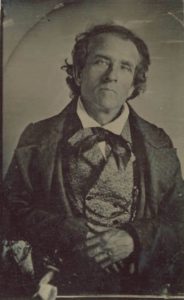 The ensuing Postal Campaign, coinciding with Turner’s Revolt, led to censorship and mass burnings across the South, not just of the mail but of Garrison in effigy. Opposing slavery in the South became dangerous to one’s health. Northern racists turned on “[N-word] lovers” as well, burning Tappan’s New York home, stoning Garrison supporters in Boston, and foiling the Anti-Slavery Society’s hope that Americans would find their moral arguments persuasive. Philadelphia was the traditional heart of abolitionism with its Quaker stronghold, but also included violent mobs that burned the abolitionist headquarters, Pennsylvania Hall, in the Lombard Street Riot. In 1837, an Illinois mob killed abolitionist publisher/minister Elijah Parish Lovejoy. Garrison radicalized, starting to oppose institutionalized Christianity and American democracy because of their associations with slavery, though he was a devout evangelical. The Constitution itself was “a pact with the devil…a covenant with death, and an agreement with hell.” When Garrison turned on the U.S. and started to support female suffrage, his society’s membership dwindled and lost its influence.
The ensuing Postal Campaign, coinciding with Turner’s Revolt, led to censorship and mass burnings across the South, not just of the mail but of Garrison in effigy. Opposing slavery in the South became dangerous to one’s health. Northern racists turned on “[N-word] lovers” as well, burning Tappan’s New York home, stoning Garrison supporters in Boston, and foiling the Anti-Slavery Society’s hope that Americans would find their moral arguments persuasive. Philadelphia was the traditional heart of abolitionism with its Quaker stronghold, but also included violent mobs that burned the abolitionist headquarters, Pennsylvania Hall, in the Lombard Street Riot. In 1837, an Illinois mob killed abolitionist publisher/minister Elijah Parish Lovejoy. Garrison radicalized, starting to oppose institutionalized Christianity and American democracy because of their associations with slavery, though he was a devout evangelical. The Constitution itself was “a pact with the devil…a covenant with death, and an agreement with hell.” When Garrison turned on the U.S. and started to support female suffrage, his society’s membership dwindled and lost its influence.
At least the Grimké sisters, now in Philadelphia, joined the abolitionists and they continued to agitate under the direction of minister Theodore Dwight Weld (right). The Grimkés also got involved in women’s emancipation after arguments among abolitionists over whether it was appropriate for the sisters to take part. When Angelina married Weld in 1838, they used a black minister and denounced the husband’s authority over his wife in their vows. While Garrison’s tactics centered on non-violent, passive resistance, his religious conviction to end slavery presaged the more violent tactics of John Brown, who took Lovejoy’s death as a sign from God to crusade against slavery. We’ll hear much more from Brown in Chapter 18 on the Sectional Crisis. And we’ll hear more from Frederick Douglas in the Civil War as he helped push Abraham Lincoln into being an abolitionist himself and using black soldiers so that African-Americans fought for their emancipation. Few of these abolitionists, white or black, realized that emancipation within America would come about so soon, during the Civil War of the 1860s. But for millions, the 1860s were too late.
Optional Reading, Listening & Viewing:
Slave Narratives from the Federal Writers’ Project, 1936-1938 (Library of Congress)
Trans-Atlantic Slave Trade Database (NEH, Emory, Harvard DuBois Institute)
Henry Louis Gates, “Did Black People Own Slaves?” (The Root, 3.4.2013)
Steven Mintz, “What Every College Graduate Should Know About Slavery: 23 Essential Facts” (IHE, 8.15.22)
Atlantic Slave Trade In Two Minutes (Salon)
The Atlantic Slave Trade & Slave Life in the Americas: A Visual Record (UVA & Virginia Foundation for the Humanities)
Contemporary Slavery in the United States (Wikipedia)
Katy Waldman, “Slave or Enslaved Person?” (Slate: History of American Slavery, 5.19.15)
Dante Stewart, “Why the Enslaved Adopted the Religion of Their Masters — And Transformed It” (Christianity Today, 2.12.18)
Anna Paulina Lee, “Slave Revolt Film Revisits History Often Omitted From Textbooks [1811 German Coast Uprising]” (Conversation, 2.27.20)
Sydney Howard Gay, Record of Fugitives National Anti-Slavery Standard (Columbia Univ. Library)
This Far By Faith: African-American Spiritual Journeys (NEH)
In Motion: The African-American Migration Experience (Schomberg Center)
Jourdan Anderson’s 1865 Letter To His Old Master (Letters of Note)
Visualizing Emancipation (Univ. of Richmond)
Gilder Lehrman: Center for the Study of Slavery, Resistance & Abolition (Yale Univ.)
Didi Kirsten Tatlow, 27 Million People Said To Live In Modern Slavery, International Herald Tribune, June 19, 2013
Liam Stack, “Debunking a Myth: The Irish Were Not Slaves, Too” (NYT, 3.17.17)
David Emery, “Were There Irish Slaves In America?” (Snopes, 9.23.16)
Joe Helm, “How Is Slavery Taught In American Schools?” (Washington Post, 8.28.19)
Alex Tizon, “My Family’s Slave,” Atlantic, June 2017
Descendants Disagree Over Nat Turner’s Legacy (CBS 60 Minutes OT)
Sandra Garcia, “She Survived A Slave Ship, the Civil War & Great Depression. Her Name Was Redoshi” (NYT, 4.3.19)
Texas Slavery Project (UVA / Univ. of North Texas)
2019 Global Slavery Index
How Many Slaves Work For You?
The Free Project
The 1619 Project (New York Times Magazine)
“12 Scholars Critique the 1619 Project & the NY Times Magazine Responds” (HNN, 1.20)
Richard Samuelson, “Cancel the New York Times” (Claremont Review of Books, 7.23.20)
Anthony DiFlorio, “How Is IBM’s Watson Fighting Against Human Trafficking?” (The Hill-Changing America, 7.20)
Manuel Barcia & John Harris, “The Slave Trade Continued Long After It Was Legal — With Lessons For Today” (HNN, 12.6.20)
Matthew Karp, “History As End: 1619, 1776, and the Politics of the Past” (Harper’s, 7.21)
Jamelle Bouie, “We Still Can’t See American Slavery For What It Was” (NYT, 1.28.22)
Vincent Brown, “One Man’s Story Offers a New Way to Understand Slave Insurrections” (TIME, 1.17.20)
Ellis P. Monk, Jr. “The Unceasing Significance of Colorism: Skin Tone Stratification in the United States” (Daedalus Spring 21 > JSTOR w. ACC ID)
Gavin Wright, “Slavery & the Rise of the Nineteenth-Century American Economy,” Journal of Economic Perspectives (Spring 2022) JSTOR w. ACC eID
